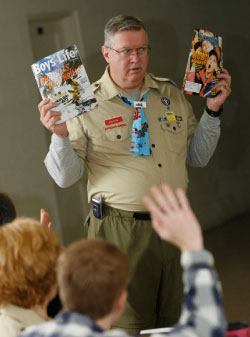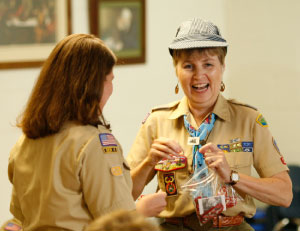There's Always Something New To Learn
By F. Lynne Bachleda
Photographs by Steve Jones
Adults who complete Scouting’s volunteer training courses have more confidence in their leadership roles and stay in the program longer.
 Participants constructed bridges by adding another building block each time they completed a phase of training. |
More than two dozen adults gathered early on a crisp, clear morning at the Valley Grove Baptist Church in Seymour, Tenn. The Great Smoky Mountains, site of the most-visited national park in America, rose in the background against a picturesquely blue sky. In just a few hours, the University of Tennessee football team would be playing at home in Knoxville, just a short stretch up the road.
Both destinations were luring temptations at the peak of a russet and gold fall. But those who filed into the church fellowship hall had a good reason to skip these enticements. They all wanted to become the best Cub Scout leaders possible by taking the BSA’s New Leader Essentials and Leader Specific Training courses.
New Tiger Cub leader Karen Bennett, mother of three sons, had recently moved to the area from New Jersey, where her eldest son had been a Boy Scout. Now her 6-year-old, William, had caught the best kind of fever: friends, fun, and camping. He had drafted Bennett to be the leader of his five-member Tiger Cub den.
Apparently planning on a long Scouting career, William had then lovingly informed her, “Mommy, you’re doing this until I’m done.” In it for the long haul, Bennett was wisely taking advantage of Cub Scouting’s recently revamped leader training.
Flexible training opportunities
Scouting’s new training continuum offers a seamless progression with little repetition of content. It also emphasizes flexibility in presentation and scheduling. For example, within the Great Smoky Mountain Council’s Sequoyah District (1,400 boys and several hundred leaders), training sessions are offered approximately three times during the school year.
Webelos den leader and assistant Scoutmaster Kimberlee Carideo said: “Making training accessible for leaders is something we strive for. In addition to open council sessions such as these, we offer training for packs and even individuals if necessary.” (In the Sequoyah District, 50 to 60 percent of the leaders are trained.)
After the Pledge of Allegiance, the morning session began with New Leader Essentials. Lasting about two hours, the presentation began with an overview of the BSA’s bedrock values—its mission statement, aims, and methods. These were presented via a quick video that included a small dose of Scouting history and its founding by retired British Army general Robert S.S. Baden-Powell. (The Cub Scout Division now recommends that New Leader Essentials take place after Leader Specific Training.)
Throughout the morning, piece-by-piece construction of paper bridges highlighted the many integrated elements of leadership.
Developmental stages of boys
The next segment touched on the developmental differences of young people—crucial information for leaders who sometimes mistakenly gauge a boy’s maturity by his height.
 Bob Kemp emphasizes the resources available in Boys' Life and Scouting magazines. |
Another short video illustrated common age-level differences. For example, most 7-year-old boys have no concept of time and little notion of consequences. By age 11, boys are growing at wildly different rates, striving to control an abundance of nervous energy, which can explode physically.
Variety is the lifeblood of any meeting; so after videos and brief lectures, the instructors introduced something completely different. Linda Goff, a member of the Cub Scout training committee for the Great Smoky Mountain Council, led the group in song. Then it was back to more learning, this time in the form of a skit that role-modeled ways to enlist parent involvement.
New leaders are often excited about becoming den leaders, but they can also become overwhelmed by their responsibilities. Ideas about where and how to get support were well covered in the New Leader Essentials session.
In addition to citing printed materials and Web site sources, the instructors encouraged the new leaders to seek others for help. Remember the mantra, “Ask! Ask! Ask!” the instructors said. The follow-up, they reminded, is to say, “Thank you! Thank you! Thank you!”
The day moved briskly forward, covering a host of topics and issues.
As one participant noted: “I never realized there was so much you needed to know to be a good leader: child motivation and development, community networking, BSA structure and funding, child safety, uniform and badges, conflict resolution, and age-appropriate programming. Wow! The list is long and really important.”
Something new to learn
After a welcome pizza break, the New Leader Essentials segment segued into Leader Specific Training.
Small-group breakout sessions gave those new to Cub Scouting an opportunity to share ideas and techniques. Experienced, trained leaders also answered questions.
 Linda Goff, right, says having fun is the key to a good training course. |
Leaders who had “graduated” with their boys from Tiger Cubs to Cub Scouts to Webelos Scouts got a chance to learn new responsibilities.
Trainer Murphy Monceaux cautioned that, “When someone changes positions, they think they already know everything and don’t need more training. But there’s always something new to learn.”
New Tiger Cub leader Karen Bennett praised the training and the Leader Specific segment in particular.
“This made me more confident as a leader by reinforcing what I already knew. I learned some new things, too, and I was able to help some other people in my situation. The books are very helpful, but I really liked this training. I’m definitely glad I did it.”
Training for specific volunteer positions is an important emphasis of the new leaders program.
Linda Goff said, “There is a high turnover of Cub Scout leaders. That makes training all the more important. We want to help adults stay in the program, so we offer training for each adult position.”
The BSA’s training continuum offers a glimpse of leadership opportunities throughout the Scouting program.
Brian Thomas, the Sequoyah District Cub Scout training chairman who managed this Saturday session, has plans to become the district’s Boy Scout leader trainer. When asked why he focuses on volunteer training, he explained:
“It’s a way to honor the excellent training experiences I’ve had. It’s also a way to give back to the program and affect many boys outside my unit. Our goal is to train every leader and provide a solid foundation for their leadership position.”
And every leader who completes a specific training course earns the right to wear the Trained Leader emblem on his or her uniform.
Tyler Rollins, who will become the next Sequoyah District Cub Scout training chairman, has a very strong reason for taking the job.
“Every boy deserves a trained leader,” he said.
F. Lynne Bachleda is the author of the regional book series Dangerous Wildlife: A Guide to Safe Encounters at Home and in the Wild (Menasha Ridge Press, 2001).
Keys to Planning an Effective Training Course- Follow the course syllabus. - Divide topics among experienced leaders. - Present information in a clear and organized manner. - Use various teaching styles. A mixture of lecture, short videos, singing (especially songs that involve movement), small-group breakouts, skits, games, and more will help maintain attention. - Cover the material but keep the pace brisk. Don’t spend a lot of time repeating the same points. - KISMIF: Keep it simple, make it fun. Create an atmosphere that keeps participants curious about what is coming next. Be sure to leave time for questions. |
Why Get Trained?Linda Goff, Cub Scout training committee member in the BSA’s Great Smoky Mountain Council, has some strong opinions on why volunteer leaders need training. “[Training] gives volunteers a sense of confidence and a knowledge base that translates into a job well done,” said Goff, a 24-year volunteer Scouter. “We have fun with our training sessions, and that attitude filters down to the boys. We want the boys to have fun while learning, too. “The bottom line is: Trained adults are more successful. They are much more likely to stay with the program, because they have the tools and resources to enjoy their vital role as volunteer leaders.” |
October 2007 Table of Contents
Copyright © 2007 by the Boy Scouts of America. All rights thereunder reserved; anything appearing in Scouting magazine or on its Web site may not be reprinted either wholly or in part without written permission. Because of freedom given authors, opinions may not reflect official concurrence.